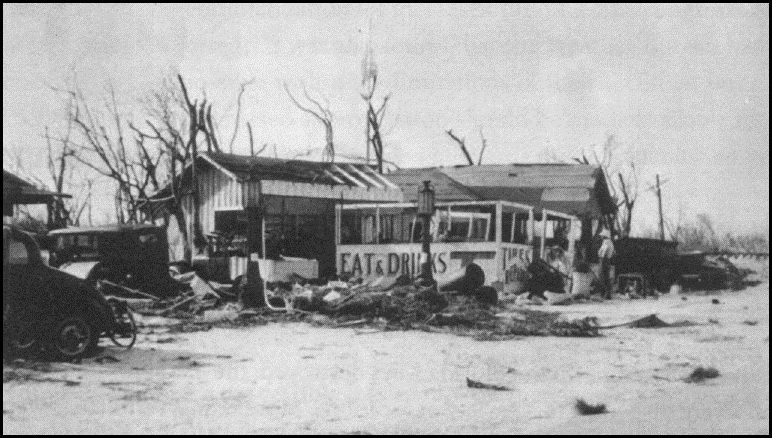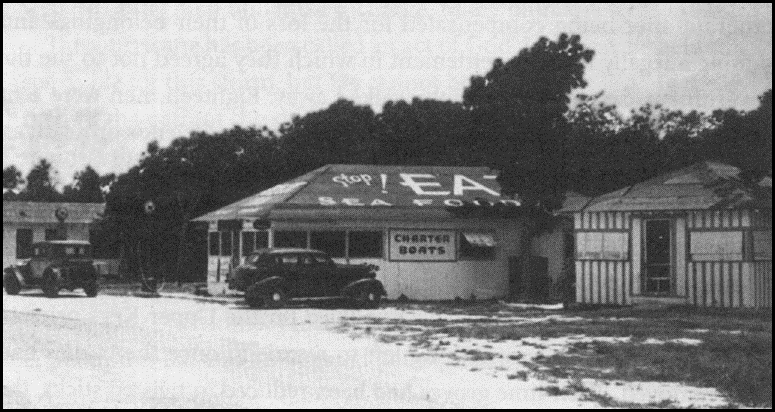
Category 5
The 1935
Labor Day
Hurricane
Thomas Neil Knowles
(University Press of Florida)

The 1935 Hurricane that hit the Florida keys in early September 1935 was a doozy. The Weather Bureau in Jacksonville said it was going to Havana, but it came ashore at Lower Matecumbe, one of the Upper Florida Keys. The barometric pressure reached 26.38 inches (typical, and normal, is around 30 inches).The storm surge that hit was estimated at eighteen feet. 485 people died, but there may have been more. Mortality records were not so exact in those days --- the Prussian need for militant exactitude was not yet part of the fabric of America.
I think of other hurricanes I have known. How different they were back when I was a sprat --- me growing up on the east coast of Florida.
A storm came to town, and it was a time for celebration. Dad stayed home from work and went around the house banging things closed, nailing doors and windows. The electricity went out (as did the electric stove) so we heated everything on the Sterno. Crackers and warm, lumpy tomato soup and cold ham-and-cheese sandwiches were the order of the day.
School was let out and when we rode our bikes around the neighborhood, fighting the wind, the only warning we got was don't pick up any fallen wires.
The wind sang around the eaves, and the doors --- with their copper stripping at the base --- moaned all the long night, and well into the day. The garden was flooded, the lawn was a morass, and the neighbors called or came by to be sure we were all right.
No police banging on the door, demanding we get out of town, no spending the day on the freeway moving at two miles an hour. No soldiers armed with machine guns, looking at everyone as potential "looters." No militia driving away those who came over to help (Aunt Millie would have not been allowed to bring us hot banana bread as she so often did in time of crises).
And no one demanded a payoff from the feds after the storm had died off and gone away. We figured it was no one's fault.
§ § §
They had no names back then, so this one here was just called the "Labor Day Hurricane." Because the center came in at a relatively unpopulated area, it was nothing like the Galveston Hurricane of 1900 (6,000 estimated dead) or the 1928 Okeechobee Hurricane (1,800 dead). But it did have its moments.
One of the high points, and probably the high point of Category Five, is the Flagler Line train sent down from Miami to pick up WWI veterans working on the Upper Keys. The train arrived at Islamorada station on Upper Matecumbe Island at 8:20 p. m. The storm arrived at the same time. Because the train was backing in, the engineer couldn't see the station; the boxcars started blowing over.
Waves coming in from the ocean "went over the cab floor and shut off the draft to the oil burner." "There we were," said the engineer, laconically. "There were times we were unable to breathe due to the water breaking over the locomotive."
At Islamorada in the vicinity of the train station, the top of the rails was 8.9 feet above mean sea level. The U. S. Army Corps of Engineers later determined that the water sweeping over the island reached a maximum of height at Islamorada of 18 feet above mean sea level.
§ § § Disasters can make for fascinating stories, but a master writer --- vide The Perfect Storm --- must worry about pacing and rhythm and must be very careful about that old bug-a-boo, sentiment. Knowles writes about one of the survivors: "He has some cuts and bruises, but it is what he does not have that sends a spear through her heart. Her husband is not holding their baby, Frank."
All they can do is gingerly cling to each other, their sobs obliterated by the wind, their tears washed away by the wind.
Despite the words, the photographs are a study, and the memories of the survivors can be touching: Elizabeth Williams, nine-years-old, recalls walking among the dead at Whale Harbor, "I can remember seeing the bodies, they were stacking them up like cordwood, and all of them were bare.
And so mother kept telling us, "Just keep your eyes on the road." And I can remember seeing the seaweed hanging on the telephone wires and wondering how it got there.
One person who lived through it called it a "wing-ding jackass of a hurricane." Congress went and had a hearing as if a hearing would stop all future hurricanes.
Our favorite part of Category Five --- outside the seaweed up there and waves crashing over Engine 457 and the lime orchards (it's where they invented Key Lime Pie) and the gumbo-limbo trees (which turned out to be safer than the buildings) --- are the names: No Name Key. Matecumbe Key. Lignumvitae Key.
And Windley Key. That's just about where the hurricane came ashore.

--- Richard Saturday